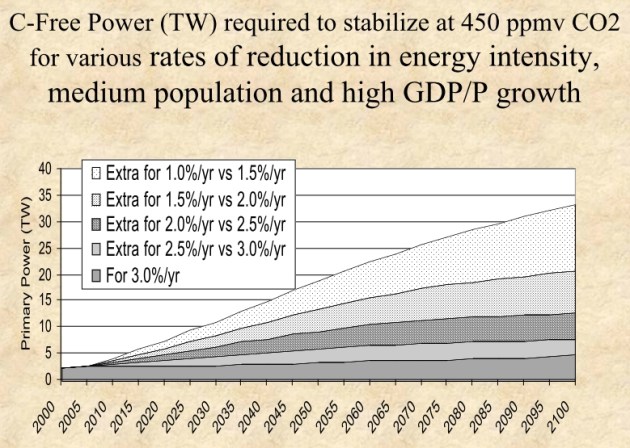 In my last two posts, I tried to explain the rebound effect and explore its implications for policy. (Short version: Rebound effects are real and in some cases substantial, but they do not undermine the case for energy efficiency.) In this post — the last in what I promise was never intended to become a multi-part series — I explore the question of what the rebound effect means for our larger understanding of the fight against climate change. Following that thread leads us into some deep waters, where we confront the climate policy dilemma that dare not speak its name: growth. Bear with me, it gets a little nerdy along the way.
In my last two posts, I tried to explain the rebound effect and explore its implications for policy. (Short version: Rebound effects are real and in some cases substantial, but they do not undermine the case for energy efficiency.) In this post — the last in what I promise was never intended to become a multi-part series — I explore the question of what the rebound effect means for our larger understanding of the fight against climate change. Following that thread leads us into some deep waters, where we confront the climate policy dilemma that dare not speak its name: growth. Bear with me, it gets a little nerdy along the way.
The most obvious and uncontroversial thing to do about rebound effects is to better understand them and incorporate them into our climate policy analysis. Most climate analysis doesn’t grapple with them at all, which cannot help but confuse our expectations and confound our efforts. We need some shared definitions, metrics, and standards for use by climate wonks.
So that’s easy. After that, things get a bit murkier.
——
Let’s take several steps back, and look at the big picture. We need to do our best to insure that global temperatures stabilize at some livable level. To the best of our understanding, doing that will require stabilizing greenhouse gas concentrations in the atmosphere at … well, depending on who you ask, 450 parts per million (ppm) or 350. The latter is certainly safer but, if we’re being honest, probably out of reach. Even 450 ppm will require immediate, sustained, and heroic efforts to reduce greenhouse gas emissions.
It’s not necessarily wise to think of climate change as an energy problem; agriculture and forestry, for instance, play huge roles. But for the sake of simplicity, let’s think of it that way and ask: What can be done around energy to forestall catastrophic climate change? The answer is, broadly speaking, twofold:
1. Increase the supply of low-carbon energy.
2. Decrease overall energy use.
The first is easy enough to understand. The second, however, requires some unpacking.
The level of energy use in an economy is the result of two factors: how big the economy is and its “energy intensity,” i.e., how much energy is required to produce a unit of GDP. Multiply an economy’s size by its energy intensity and you get the amount of energy it uses.
If an economy is growing at a faster rate than its energy intensity is falling, then total energy use will rise. (This is basically what’s been going on for the last century — the energy intensity of the global economy has been falling, but the global economy has been growing at a much faster rate, so total energy use has been rising.) If, however, an economy’s energy intensity falls at a faster rate than it is growing, total energy use will decline. Make sense?
Once things are framed this way, it’s clear that there are actually two ways to reduce global energy use:
2a. Drive down global energy intensity.
2b. Drive down global economic growth.
——
It is a simple matter of math to say that the more you do of any one of these (1, 2a, or 2b), the less you have to do of the others. If we could twinkle our noses and replace the entire global energy supply with low-carbon power tomorrow, we could grow as fast as we want and there would be little need to be more energy efficient (at least from a climate perspective).
But we cannot so twinkle. Replacing global energy supply, even if there were miraculous technological breakthroughs tomorrow, will take more time than we have to spare. If we want to hit reasonable climate targets, we have to reduce energy use. There’s no way around it.
It doesn’t take a political savant to see that, between the two options for reducing energy use, 2a is the more popular. Virtually no one, ever, anywhere, talks openly about slowing economic growth as a means of mitigating climate change. Instead, everyone supports the grand ideal of decreasing energy use even as the economy grows (i.e., reducing energy intensity).
So let’s assume, as most economists do, that 2b is off the table. The global economy will continue to grow, at a relatively high rate, throughout the century. If that’s true, then our only way to reduce energy use is by decreasing energy intensity.
The graph below illustrates something crucially important: the more we decrease energy intensity, the less low-carbon energy we’ll need. (“C-free” means carbon-free. “TW” means terawatts.)
For reference, over the last century, the average decline in global energy intensity has been around 1 percent a year. The chart shows that (given certain assumptions about population and economic growth) if we continue with our pace of 1 percent a year, we will need almost 35 terawatts of clean energy supply by 2100 to stay in the zone of climate safety. For reference, in 2008 the world consumed 15 TW of energy total. So by the end of the century we’d have to replace the entire global energy supply more than twice over with low-carbon energy. That is … daunting.
However, if we boost the rate of decline in energy intensity by even 0.5 percent, we can bring down the need for clean energy in 2100 to around 20 TW. Avoiding 15 TW — the amount the entire world uses today — is no small thing!
And if we get really jiggy with it and push the energy intensity decline rate all the way up to 3 percent a year, we’ll need less than 5 TW of clean energy by 2100, which is totally f’ing doable!
It is, therefore, vital to know how much and how fast we can reduce global energy intensity.
——
This is where the rebound effect comes in.
It turns out, the two determinants of energy use — the energy intensity decline rate and the GDP growth rate, respectively — are not independent of one another. They interact in complex, nonlinear ways that we do not yet fully understand.
One thing we can say with a decent degree of confidence, though, is that all things being equal, decreasing energy intensity will increase economic growth. When people save money on energy, they spend the money elsewhere, which stimulates growth. It’s no different than what happens when labor productivity increases. People don’t work less, they make more stuff! That’s what the rebound effect is.
I don’t think we’re anywhere close to knowing exactly how to quantify the global economy-wide rebound effect. It’s a devilish problem. You can’t run experiments, after all, or examine a separate world where energy intensity stayed the same. You can only construct models and make educated guesses.
Nonetheless, we know for sure that the naive way of looking at it — energy intensity falls a unit, so energy use falls a unit — is wrong. For every one step forward we take on efficiency, we take a half step (or a third of a step, or two-thirds of a step, or whatever) back on rebound. That means we need two or three or four times more efficiency than we thought to hit the familiar energy-use reduction targets in most climate scenarios.
In other words: driving down energy use by driving down energy intensity is much more difficult than it looks (and much more difficult than we seem to be planning for).
——
There’s yet more grim news on the energy intensity front.
Changes in energy intensity are a result of two basic forces. The first is energy-efficiency improvements within various sectors of the economy. These are called “within-sector” or “sectoral” improvements and they’re most a result of better technology — more efficient turbines and cars and HVAC systems and such.
The second is structural shifts within an economy from one set of sectors to another. When an economy moves from peasant agriculture to heavy industry, its energy intensity increases. When it moves from heavy industry to services, its energy intensity declines. And so on.
Here’s the thing: Public policy can accelerate sectoral efficiencies, but policymakers have very little control or influence over the macroeconomic forces involved in sectoral shifts. And it turns out that the latter, generally speaking, does more to bring down energy intensity than the former. Take one of the purported success stories of efficiency, California, which since the early 1970s has held per-capita energy use roughly constant even as it has risen by about 40 percent in the rest of the U.S. In a paper called “Deconstructing the ‘Rosenfeld Curve,’” scholars James Sweeney and Anant Sudarshan conclude that only 23 percent of California’s divergence from the broader U.S. trend can be explained through policy-driven sectoral efficiencies. The rest has to do with structural shifts in the economy, mainly the exodus of heavy, carbon-intensive industry. In other words, only about a quarter of the California efficiency success story was “on purpose.”
In a paper called “Calculating economy-wide energy intensity decline rate: The role of sectoral output and energy shares,” scholars Soham Baksi and Chris Green attempt to figure out how much we can realistically expect to drive energy intensity down in the coming century. (Thanks to Jesse Jenkins for tipping me off to both papers cited in this section.) They too find that structural shifts do most of the work. Their conclusion: “For all the ‘likely’ scenarios, the global average rate of energy intensity decline ranged between 0.9% and 1.2% per annum” between 1990 and 2100.
That is roughly in line with the historical rate of decline. What if sectoral efficiency improvements can be pushed farther than most estimates? Baksi and Green checked. They ran a scenario in which efficiency improvement in residential was bumped from 300 percent to 600 percent, in commercial from 200 to 600, in transportation and industrial from 200 to 400.
Surprisingly, even these large increases in sectoral energy efficiency improvements raise the overall energy intensity decline rate by a modest amount — from 1.03% to 1.25% per annum. [my emphasis]
Hm. That’s discouraging. So what kind of sectoral efficiency improvements would be required to push the energy intensity decline rate all the way up to 2 percent a year? Up to 1,000 percent. Yes, 1,000 percent.
Again: daunting.
——
Okay, suppose we raise sectoral efficiency by 1,000 percent. Crazier things have happened. (Actually, nothing like that has ever happened, but bear with me.) That will get our energy intensity decline rate up to 2 percent.
But remember: To reduce total energy use, we have to get the energy-intensity decline rate above the rate of economic growth. In the post-WWII era, the U.S. economy has grown at an average rate of around 3.3 percent annually. Since 1989, China’s economy has grown at an average rate of about 9.3 percent annually.
In other words, it looks like it will be extremely difficult to drive energy-intensity decline faster than economic growth.
And as we discussed earlier, it will also be extremely difficult to scale up low-carbon energy fast enough, especially in the short- to mid-term.
So what option does that leave us? It seems we’re back to 2b, the option that dare not speak its name: suppressing economic growth.
I have some thoughts to share on that subject, but I think we can all agree that this post has gone on long enough. So (self-parody alert!) it looks like I lied when I said this would be the last post in this series. Part four coming soon!




